|
Crooks and Liars
|
|
New Nevada Agriculture Director
Takes Aim at Wild Horses
Part Thirty Three
|
News From the Front - May 21, 2008
WHERE ARE ALL THE HORSES?
"Doctor Spin"
A number of the horse volunteers have actually had careers in governmental bureaucracies so they are well familiar with the old adage, "Figures can lie and liars can figure."
As we reported last week, Dr. Phil Larussa presented in his packet to the Board a map that claimed that 70% of the horses are within a circle that encompassed VRWPA, TRW and a small fragment of TRI. Here's the map again.
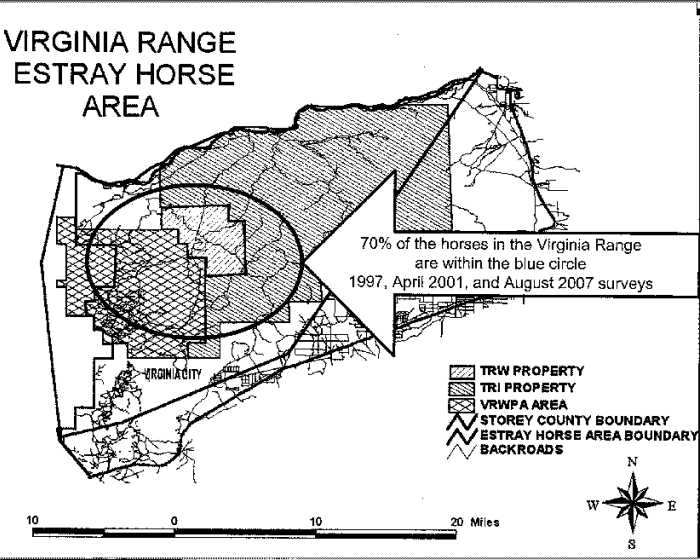 We have digital copies of most of the aerial survey maps and Dr. Larussa's contention is pure nonsense.
We have digital copies of most of the aerial survey maps and Dr. Larussa's contention is pure nonsense.
First off, there are usually one to two aerial surveys done each year and Dr. Larussa doesn't refer to the average of all the surveys but anchors his calculations on only three surveys, "1997, April 2001 and August 2007."
1997 Survey
The 1997 survey only counted 413 horses and its validity is questionable, both on the basis of accuracy and on the basis that the size of a horse population directly impacts its distribution. A horse count of 413 is not reflective of what the NDoA claims is the current population on the range.
April 2001 Survey
This survey is interesting as this second census was taken in April before the majority of the horses disbursed following VRWPA's winter feeding program. Here is a reproduction of that survey from the digital archive. Each dot represents a band of horses.
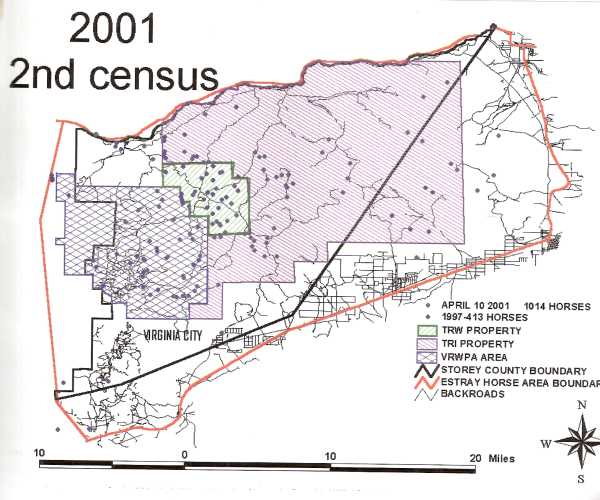
The second census for 2000 was taken in August. Although this census was taken the year previous to Dr. Larussa's example, this data reflects a more typical summer distribution of the horses - where they could be found when they were not being fed by the VRWPA.
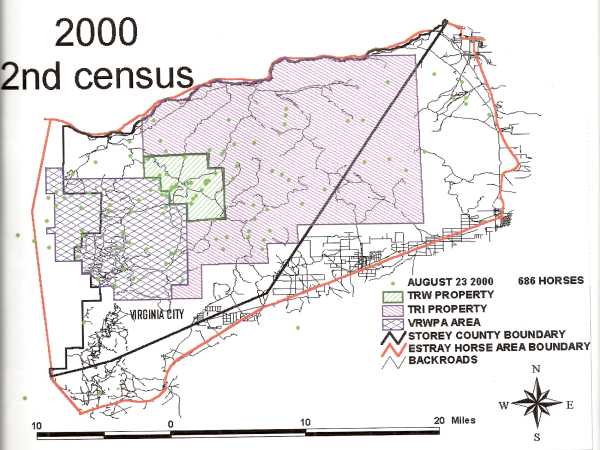
2007 Survey
A more contemporary picture can be drawn from the 1-29-07 aerial census (the latest for which we have digital data.) Please note that the horses weren't being fed by VRWPA at that time so they disbursed their grazing pressure across the range. Furthermore there have been some issues raised about the accuracy of the GPS data from the August census so we're going to go with the January survey.
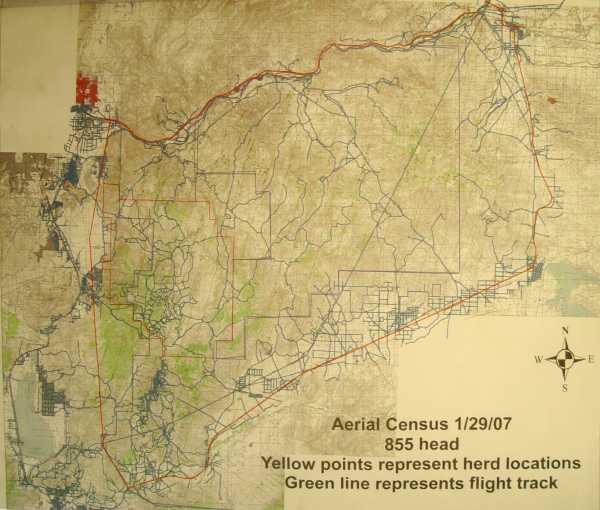
The actual digital map shows the counts associated with each "band" of horses spotted.
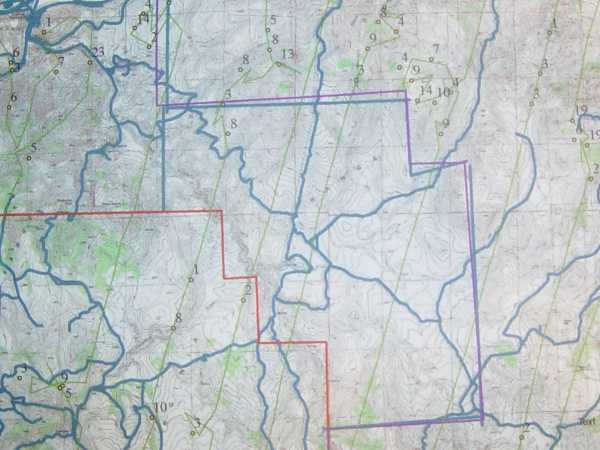
So how are the horses really disbursed?
VRWPA
14 bands, 86 horses.
Actual counts: 9, 1, 2, 8, 17, 5, 3, 9, 5, 10, 3, 3, 6, 5
Hidden Valley
12 bands, 87 horses
Actual counts: 1, 4, 14, 6, 7, 23, 3, 2, 6, 7, 5, 9
TRW
2 bands, 11 horses
Actual counts: 3, 8
Tahoe Reno Industrial (TRI)
62 bands, 446 horses
Actual counts: 2, 6, 4, 36, 6, 5, 8, 13, 8, 2, 5, 8, 4, 9, 3, 4, 8, 3,
11, 3, 7, 5, 5, 4, 10, 14, 9, 7, 9, 7, 3, 8, 9, 19, 22, 4, 1, 3, 3,
13, 8, 19, 6, 19, 9, 2, 5, 15, 9, 9, 2, 12, 5, 2, 4,
2, 2, 3, 4, 1, 1, 2
Lyon County
28 bands, 207 horses
Actual counts: 3, 6, 1, 3, 1, 9, 10, 5, 17, 10, 5, 6, 10, 11, 4, 15, 6, 9, 15, 12, 8, 5, 12, 3, 2, 9, 3, 7
Other
2 bands, 20 horses
Actual counts: 6, 14
TOTALS
120 bands, 857 horses
Notes
Our count based on the figures that appeared on the digital map produced a total of 857 horses as compared with NDoA's total of 855, however we'll accept NDoA's number.
Fixed wing surveys are not as accurate as helicopter surveys and the results produced could be a 10% - 12% undercount. However the actual "on the ground" horse distribution should be similar to what was plotted on the count.
What is quite clear is that based on this count is that about 52% of the Virginia Range horses were found within the boundaries of the Tahoe Reno Industrial Center, a location where the properties are welcome. Nearly another quarter of the herd were found on NRI and other tracts where the presence of the horses are acknowledged by the landowners as acceptable, and the VRWPA and Hidden Valley folks are fighting to protect the horses in their areas so the presence of horses in those locations don't seem to pose much of a problem.
The data supports the argument that the majority of horse problems relate to a very small number of ranchers who operate by letting their cattle roam all over other people's property, and on BLM tracts without authorization, and who then complain about competition from the wild horses. Residential developments adjacent to the open range that are inadequately fenced, and residents new to the area who don't understand Nevada's fence-out law and complain about horses, cattle and coyotes that visit their property, also contribute to horse related complaints. It is not the taxpayers' responsibility to fund an expensive removal program to accommodate a few people who don't understand open range law.
Finally, the data also supports the argument that there is no immediate horse crisis and current collaborative management strategies, while they could use a little refinement, are working.
Twelve Horses Video
The media development firm Twelve Horses put a copy of their pro horse video on YouTube. It can be viewed here.
Wild Horses at Risk in Nevada
The spirit of Thomas Paine lives

|

